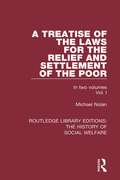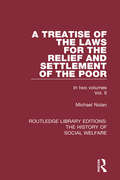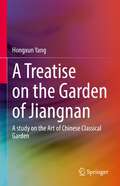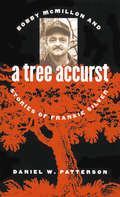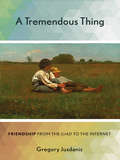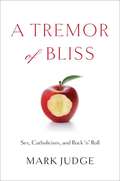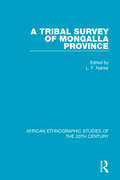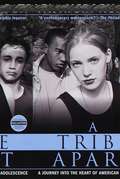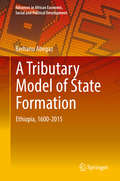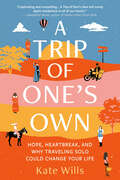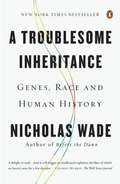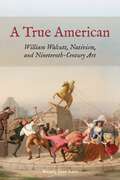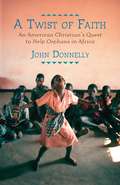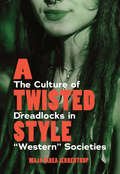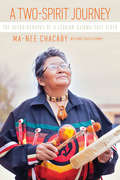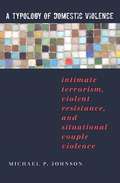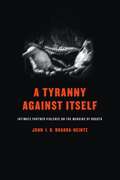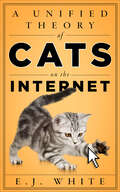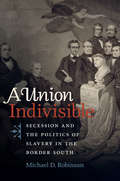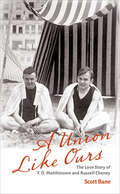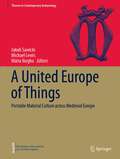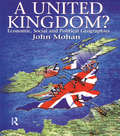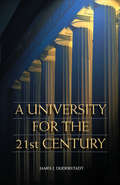- Table View
- List View
A Treatise of the Laws for the Relief and Settlement of the Poor: Volume I (Routledge Library Editions: The History of Social Welfare)
by Michael NolanFirst published in 1805, this work summarises the vast array of laws at the time on the relief of the poor in Great Britain. Split across two volumes, it not only condenses the laws themselves but also disentangles the theory and doctrine of each law and explains how the theory should have been applied in practice. This work will be a valuable primary source for those studying 19th poor relief and welfare.
A Treatise of the Laws for the Relief and Settlement of the Poor: Volume II (Routledge Library Editions: The History of Social Welfare)
by Michael NolanFirst published in 1805, this work summarises the vast array of laws at the time on the relief of the poor in Great Britain. Split across two volumes, it not only condenses the laws themselves but also disentangles the theory and doctrine of each law and explains how the theory should have been applied in practice. This work will be a valuable primary source for those studying 19th poor relief and welfare.
A Treatise on the Garden of Jiangnan: A study on the Art of Chinese Classical Garden
by Hongxun YangThis book presents a study into the art of Jiangnan classical garden. Jiangnan (“the south of the Yangtze River”) refers to the water network region along the lower reaches of the Changjiang River (formerly known as Yangtze River), where Jiangsu Province Chinese gardens were primarily constructed during the 16th and 17th centuries of the later Ming and early Qing dynasties. The Jiangnan garden, an architectural space where artificial and natural elements are combined, represents the elite of classical Chinese gardens and serves as a prime exemplar for its northern counterpart, the Ming and Qing imperial gardens.The book pursues an interdisciplinary approach, combining historical information with case studies and other methods. Charts and pictures are used to supplement and reinforce the conclusions drawn from the macro narrative, enhancing the authenticity and readability of the historical monographs. It represents the first study of the classical art of landscape design in China, offering readers an insightful introduction.
A Tree Accurst
by Daniel W. PattersonOn a wintry night in 1831, a man named Charlie Silver was murdered with an axe and his body burned in a cabin in the mountains of North Carolina. His young wife, Frankie Silver, was tried and hanged for the crime. In later years people claimed that a tree growing near the ruins of the old cabin was cursed--that anyone who climbed into it would be unable to get out. Daniel Patterson uses this "accurst" tree as a metaphor for the grip the story of the murder has had on the imaginations of the local community, the wider world, and the noted Appalachian traditional singer and storyteller Bobby McMillon.For nearly 170 years, the memory of Frankie Silver has been kept alive by a ballad and local legends and by the news accounts, fiction, plays, and other works they inspired. Weaving Bobby McMillon's personal story--how and why he became a taleteller and what this story means to him--into an investigation of the Silver murder, Patterson explores the genesis and uses of folklore and the interplay between folklore, social and personal history, law, and narrative as people and communities try to understand human character and fate.Bobby McMillon is a furniture and hospital worker in Lenoir, North Carolina, with deep roots in Appalachia and a lifelong passion for learning and performing traditional songs and tales. He has received a North Carolina Folk Heritage Award from the state's Arts Council and also the North Carolina Folklore Society's Brown-Hudson Folklore Award.
A Tremendous Thing: Friendship from the "Iliad" to the Internet
by Gregory Jusdanis"Why did you do all this for me?" Wilbur asked. "I don't deserve it. I've never done anything for you." “You have been my friend,” replied Charlotte. “That in itself is a tremendous thing.” —from Charlotte's Web by E. B. White Friendship encompasses a wide range of social bonds, from playground companionship and wartime camaraderie to modern marriages and Facebook links. For many, friendship is more meaningful than familial ties. And yet it is our least codified relationship, with no legal standing or bureaucratic definition. In A Tremendous Thing, Gregory Jusdanis explores the complex, sometimes contradictory nature of friendship, reclaiming its importance in both society and the humanities today. Ranging widely in his discussion, he looks at the art of friendship and friendship in art, finding a compelling link between our need for friends and our engagement with fiction. Both, he contends, necessitate the possibility of entering invented worlds, of reading the minds of others, and of learning to live with people. Investigating the ethics, aesthetics, and politics of friendship, Jusdanis draws from the earliest writings to the present, from the Epic of Gilgamesh and the Iliad to Charlotte's Web and “Brokeback Mountain,” as well as from philosophy, sociology, evolutionary biology, psychology, and political theory. He asks: What makes friends stay together? Why do we associate friendship with mourning? Does friendship contribute to the formation of political communities? Can friends desire each other? The history of friendship demonstrates that human beings are a mutually supportive species with an innate aptitude to envision and create ties with others. At a time when we are confronted by war, economic inequality, and climate change, Jusdanis suggests that we reclaim friendship to harness our capacity for cooperation and empathy.
A Tremor of Bliss: Sex, Catholicism, and Rock 'n' Roll
by Mark JudgeUp to the current day, matters of sexual morality—including contraception, abortion, premarital sex, and gay marriage—have polarized the Catholic Church. In the wake of the turmoil of the 1960s, when liberal theologians challenged the Church’s traditional views on the subject, a schism has opened. Much of the world, and many Catholics themselves, believe that the views of each camp are clear and well defined. As Mark Judge reveals in this trenchant and illuminating defense of the teachings of his Church, this is far from the case. Without sensationalism, Judge is candid here about his personal journey from the playgrounds of the sexual revolution to his eventual belief in the need to combine sexuality with love and commitment to another person, not as an end in itself but rather as a particularly direct means of opening oneself up to God’s love. He also sees support for the Christian theology on love in a seemingly unlikely place: rock music. He delves into the Church’s teachings on sexual matters, going back to the time of Saint Augustine, Saint Thomas Aquinas, Saint John of the Cross, and Pope John Paul II while also acquainting us with more contemporary voices from within the Church—as well as from the pop charts.From the Trade Paperback edition.
A Tribal Survey of Mongalla Province
by L. F. NalderOriginally published in 1937, this book describes and compares the tribes of the Mongalla Province in what is now South Sudan. In the second part of the book some 27 individual tribes are discussed in detail, and topics such as linguistics, culture, tribal structure, religious beliefs, crime and punishment, marriage, birth, burial and economic and agricultural life are also covered.
A Tribe Apart: A Journey into the Heart of American Adolescence
by Patricia HerschFor three fascinating, disturbing years, writer Patricia Hersch journeyed inside a world that is as familiar as our own children and yet as alien as some exotic culture--the world of adolescence. As a silent, attentive partner, she followed eight teenagers in the typically American town of Reston, Virginia, listening to their stories, observing their rituals, watching them fulfill their dreams and enact their tragedies. What she found was that America's teens have fashioned a fully defined culture that adults neither see nor imagine--a culture of unprecedented freedom and baffling complexity, a culture with rules but no structure, values but no clear morality, codes but no consistency.Is it society itself that has created this separate teen community? Resigned to the attitude that adolescents simply live in "a tribe apart," adults have pulled away, relinquishing responsibility and supervision, allowing the unhealthy behaviors of teens to flourish. Ultimately, this rift between adults and teenagers robs both generations of meaningful connections. For everyone's world is made richer and more challenging by having adolescents in it.
A Tributary Model of State Formation: Ethiopia, 1600-2015 (Advances in African Economic, Social and Political Development)
by Berhanu AbegazA Tributary Model of State Formation: Ethiopia, 1600-2015 addresses the perplexing question of why a pedigreed Ethiopian state failed to transform itself into a nation-state. Using a comparative-institutionalist framework, this book explores why Ethiopia, an Afroasian civilizational state, has yet to build a modern political order comprising a sturdy state, the rule of law, and accountability to the ruled. The book provides a theoretical framework that contrasts the European and the Afroasian modes of state formation and explores the three major variants of the Ethiopian state since 1600 (Gondar, Shewa, and Revolutionary). It does this by employing the conceptual entry point of tributarism and teases out the implications of this perspective for refashioning the embattled postcolonial African political institutions. The primary contribution of the book is the novel framing of state formation through the lens of a landed Afroasiatic peasantry in giving rise to a fragile state whose redistributive preoccupation preempted the emergence of a productive economy to serve as a buoyant revenue base. Unlike feudal Europe, the dependence of the Afroasian state on arm’s-length overlordship rather than on tightly-managed landlordship incentivized endemic extractive contests among elites with the capacity for violence for the non-fixed tribute from independent wealth producers. Tributarism, I argue here, stymied the transition from a resilient statehood to a robust nation-statehood that befits an open-order society. This book will be of interest to scholars in economics, political science, political economics, and African Studies. Berhanu Abegaz is Professor of Economics, College of William & Mary (USA).
A Trip of One's Own: Hope, Heartbreak, and Why Traveling Solo Could Change Your Life
by Kate WillsAre you ready to embark on a life-altering adventure that will redefine your perspectives and open your heart to boundless possibilities? In this compelling memoir, travel writer Kate Wills fearlessly delves into her personal experiences, weaving a captivating narrative of hope, healing, and self-discovery. With courage as her compass, she embarks on solo expeditions across the globe, unearthing profound insights along the way.Follow Kate on her adventures through bustling cities, awe-inspiring landscapes, and tranquil retreats. Feel the rush of adrenaline as she embraces thrilling escapades, and share in her moments of vulnerability as she navigates through heartbreak and loneliness.A Trip of One's Own not only showcases the sheer joy of independent travel but also delves into the empowering and life-changing effects it can have. As you turn each page, you'll find yourself irresistibly drawn into Kate's world, feeling the warmth of new friendships and experiencing the freedom that only solo travel can offer. Embrace her triumphs, share her laughter, and learn from her challenges as you embark on this remarkable voyage together.A Trip of One's Own is not just a travel memoir; it's a profound testament to the transformative power of traversing the world on your own terms. Whether you're a seasoned traveler or a novice adventurer, this book will ignite your wanderlust and motivate you to chart your course towards self-discovery and personal growth.
A Troubled Marriage: Domestic Violence and the Legal System
by Leigh GoodmarkChoice's Outstanding Academic Title list for 2013The development of a legal regime to combat domestic violence in the United States has been lauded as one of the feminist movement’s greatest triumphs. But, Leigh Goodmark argues, the resulting system is deeply flawed in ways that prevent it from assisting many women subjected to abuse. The current legal response to domestic violence is excessively focused on physical violence; this narrow definition of abuse fails to provide protection from behaviors that are profoundly damaging, including psychological, economic, and reproductive abuse. The system uses mandatory policies that deny women subjected to abuse autonomy and agency, substituting the state’s priorities for women’s goals. A Troubled Marriage is a provocative exploration of how the legal system’s response to domestic violence developed, why that response is flawed, and what we should do to change it. Goodmark argues for an anti-essentialist system, which would define abuse and allocate power in a manner attentive to the experiences, goals, needs and priorities of individual women. Theoretically rich yet conversational, A Troubled Marriage imagines a legal system based on anti-essentialist principles and suggests ways to look beyond the system to help women find justice and economic stability, engage men in the struggle to end abuse, and develop community accountability for abuse.
A Troublesome Inheritance
by Nicholas WadeDrawing on startling new evidence from the mapping of the genome, an explosive new account of the genetic basis of race and its role in the human story Fewer ideas have been more toxic or harmful than the idea of the biological reality of race, and with it the idea that humans of different races are biologically different from one another. For this understandable reason, the idea has been banished from polite academic conversation. Arguing that race is more than just a social construct can get a scholar run out of town, or at least off campus, on a rail. Human evolution, the consensus view insists, ended in prehistory. Inconveniently, as Nicholas Wade argues in A Troublesome Inheritance, the consensus view cannot be right. And in fact, we know that populations have changed in the past few thousand years--to be lactose tolerant, for example, and to survive at high altitudes. Race is not a bright-line distinction; by definition it means that the more human populations are kept apart, the more they evolve their own distinct traits under the selective pressure known as Darwinian evolution. For many thousands of years, most human populations stayed where they were and grew distinct, not just in outward appearance but in deeper senses as well. Wade, the longtime journalist covering genetic advances for The New York Times, draws widely on the work of scientists who have made crucial breakthroughs in establishing the reality of recent human evolution. The most provocative claims in this book involve the genetic basis of human social habits. What we might call middle-class social traits--thrift, docility, nonviolence--have been slowly but surely inculcated genetically within agrarian societies, Wade argues. These "values" obviously had a strong cultural component, but Wade points to evidence that agrarian societies evolved away from hunter-gatherer societies in some crucial respects. Also controversial are his findings regarding the genetic basis of traits we associate with intelligence, such as literacy and numeracy, in certain ethnic populations, including the Chinese and Ashkenazi Jews. Wade believes deeply in the fundamental equality of all human peoples. He also believes that science is best served by pursuing the truth without fear, and if his mission to arrive at a coherent summa of what the new genetic science does and does not tell us about race and human history leads straight into a minefield, then so be it. This will not be the last word on the subject, but it will begin a powerful and overdue conversation.
A Troublesome Inheritance: Genes, Race and Human History
by Nicholas WadeDrawing on startling new evidence from the mapping of the genome, an explosive new account of the genetic basis of race and its role in the human story Fewer ideas have been more toxic or harmful than the idea of the biological reality of race, and with it the idea that humans of different races are biologically different from one another. For this understandable reason, the idea has been banished from polite academic conversation. Arguing that race is more than just a social construct can get a scholar run out of town, or at least off campus, on a rail. Human evolution, the consensus view insists, ended in prehistory.Inconveniently, as Nicholas Wade argues in A Troublesome Inheritance, the consensus view cannot be right. And in fact, we know that populations have changed in the past few thousand years--to be lactose tolerant, for example, and to survive at high altitudes. Race is not a bright-line distinction; by definition it means that the more human populations are kept apart, the more they evolve their own distinct traits under the selective pressure known as Darwinian evolution. For many thousands of years, most human populations stayed where they were and grew distinct, not just in outward appearance but in deeper senses as well.Wade, the longtime journalist covering genetic advances for The New York Times, draws widely on the work of scientists who have made crucial breakthroughs in establishing the reality of recent human evolution. The most provocative claims in this book involve the genetic basis of human social habits. What we might call middle-class social traits--thrift, docility, nonviolence--have been slowly but surely inculcated genetically within agrarian societies, Wade argues. These "values" obviously had a strong cultural component, but Wade points to evidence that agrarian societies evolved away from hunter-gatherer societies in some crucial respects. Also controversial are his findings regarding the genetic basis of traits we associate with intelligence, such as literacy and numeracy, in certain ethnic populations, including the Chinese and Ashkenazi Jews.Wade believes deeply in the fundamental equality of all human peoples. He also believes that science is best served by pursuing the truth without fear, and if his mission to arrive at a coherent summa of what the new genetic science does and does not tell us about race and human history leads straight into a minefield, then so be it. This will not be the last word on the subject, but it will begin a powerful and overdue conversation.From the Trade Paperback edition.
A True American: William Walcutt, Nativism, and Nineteenth-Century Art
by Wendy Jean KatzThis book argues that nativism, the hostility especially to Catholic immigrants that led to the organization of political parties like the Know-Nothings, affected the meaning of nineteenthcentury American art in ways that have gone unrecognized. In an era of industrialization, nativism’s erection of barriers to immigration appealed to artisans, a category that included most male artists at some stage in their careers. But as importantly, its patriotic message about the nature of the American republic also overlapped with widely shared convictions about the necessity of democratic reform. Movements directed toward improving the human condition, including anti-slavery and temperance, often consigned Catholicism, along with monarchies and slavery, to a repressive past, not the republican American future. To demonstrate the impact of this political effort by humanitarian reformers and nativists to define a Protestant character for the country, this book tracks the work and practice of artist William Walcutt. Though he is little known today, in his own time his efforts as a painter, illustrator and sculptor were acclaimed as masterly, and his art is worth reconsidering in its own right. But this book examines him as a case study of an artist whose economic and personal ties to artisanal print culture and cultural nationalists ensured that he was surrounded by and contributed to anti-Catholic publications and organizations. Walcutt was not anti immigrant himself, nor a member of a nativist party, but his kin, friends, and patrons publicly expressed warnings about Catholic and foreign political influence. And that has implications for better-known nineteenth-century historical and narrative art. Precisely because Walcutt’s profile and milieu were so typical for artists in this period, this book is able to demonstrate how central this supposedly fringe movement was to viewers and makers of American art.
A Twist of Faith: An American Christian's Quest to Help Orphans in Africa
by John DonnellyAmerican Christians, veteran reporter John Donnelly has discovered, are an ever-increasing source of aid in Africa, with some experts estimating that U. S. churches supply more resources to Africa than USAID. InA Twist of Faith, he tells the unlikely story of how faith and determination compelled one such American Christian to travel to Africa and open a school for children orphaned by the AIDS epidemic. David Nixon, a carpenter from North Carolina who had lived through his share of trouble, knew nothing about the small, land-locked African country of Malawi. But after having a religious awakening and hearing about a preacher's efforts to aid its impoverished and beleaguered citizens, he raises money from his church and sets off to do what so many well-intentioned Americans of faith do in Africa: build an orphanage. But as his plans are beset with difficulties, Nixon slowly comes to realize that helping others requires listening to and learning from them. And that means changing his preconceived ideas of what the Malawians need and how he can best serve them. A Twist of Faithis the story of one man who, despite personal struggles, a profound cultural gap, the corruption of local officials, and the heartbreak of losing an orphan he comes to love, saves himself by saving others in a place nothing like home. Nixon's story is representative of a growing trend: the thousands of American Christians who are impassioned donors of time, money, and personal energy, devoted to helping African children.
A Twisted Style: The Culture of Dreadlocks in “Western” Societies
by Maja Tabea JerrentrupIn "western" cultures, some people have chosen a dreadlock hairstyle, despite many in mainstream society looking at it in a negative light. This book deals with contradictions surrounding the hairstyle such as often representing a protest against the prevailing right-wing political systems, yet also emphasizing the white person’s power to appropriate any style. Based on interviews and close observations in social media, the book offers insights into the culture(s) surrounding dreadlocks and ultimately interprets the phenomenon as a postmodern form of individuality.
A Two-Spirit Journey: The Autobiography of a Lesbian Ojibwa-Cree Elder
by Ma-Nee ChacabyFrom her early, often harrowing memories of life and abuse in a remote Ojibwa community, Ma-Nee Chacaby's extraordinary story is one of enduring and ultimately overcoming the social and economic legacies of colonialism. As a child, Chacaby learned spiritual and cultural traditions from her Cree grandmother and trapping, hunting, and bush survival skills from her Ojibwa stepfather. She also suffered physical and sexual violence, and in her teen years became an alcoholic herself. At twenty, Chacaby took her children and, fleeing an abusive marriage, moved to Thunder Bay. Despite the abuse, racism, and indifference she often found there, Chacaby marshalled the strength and supports to help herself and others. Over the following decades, she achieved sobriety, trained and worked as an alcoholism counsellor, raised her children and fostered many others, learned to live with visual impairment, and came out as a lesbian. In 2013, Chacaby led the first gay pride parade in Thunder Bay. Ma-Nee Chacaby has emerged from hardship grounded in faith, compassion, and humour. Her memoir provides unprecedented insights into the challenges still faced by many Indigenous people.
A Typology of Domestic Violence: Intimate Terrorism, Violent Resistance, and Situational Couple Violence
by Michael P. JohnsonThis volume begins the work of theorizing forms of domestic violence, a crucial first step to a better understanding of these phenomena among scholars, social scientists, policy makers, and service providers.
A Tyranny Against Itself: Intimate Partner Violence on the Margins of Bogotá
by John I. Bhadra-HeintzUsme, one of the peripheral districts surrounding Bogotá, Colombia, is one of the poorest, most populous, and most marginalized outer districts of the city, with a high concentration of indigenous occupants. Over eighty percent of Usme’s women have experienced partner violence or some kind of partner-controlling behavior.How does one go about understanding the perpetration of partner violence? Based on ethnographic work with survivors, responders, and most of all the perpetrators of this kind of abuse, scholar John I.B. Bhadra-Heintz explores this issue in A Tyranny Against Itself. Throughout this study, Bhadra-Heintz examines how this violence is made possible, how it is positioned to be permissible socially, and what is at stake for those who are involved.This violence is examined as a question of sovereignty on the intimate scale. Not the product of a particular cultural pathology, a phenomenon that can otherwise be otherized, this book seeks instead to find the lines of connection, and contradiction, that tie these intimate acts of violence into broader regimes of power. In a community so profoundly shaped by centuries of political conflict, only through this kind of approach can new apertures for engagement be found. Through them, this book outlines new vulnerabilities in this form of abuse, and along the way imagines new ways of escaping from these everyday acts of intimate terror and the broader systems of violence in which they are involved.
A Unified Theory of Cats on the Internet
by E.J. WhiteHow cats became the undisputed mascot of the internet. The advertising slogan of the social news site Reddit is "Come for the cats. Stay for the empathy." Journalists and their readers seem to need no explanation for the line, "The internet is made of cats." Everyone understands the joke, but few know how it started. A Unified Theory of Cats on the Internet is the first book to explore the history of how the cat became the internet's best friend. Internet cats can differ in dramatic ways, from the goth cats of Twitter to the glamourpusses of Instagram to the giddy, nonsensical silliness of Nyan Cat. But they all share common traits and values. Bringing together fun anecdotes, thoughtful analyses, and hidden histories of the communities that built the internet, Elyse White shows how japonisme, punk culture, cute culture, and the battle among different communities for the soul of the internet informed the sensibility of online felines. Internet cats offer a playful—and useful—way to understand how culture shapes and is shaped by technology. Western culture has used cats for centuries as symbols of darkness, pathos, and alienation, and the communities that helped build the internet explicitly constructed themselves as outsiders, with snark and alienation at the core of their identity. Thus cats became the sine qua non of cultural literacy for the Extremely Online, not to mention an everyday medium of expression for the rest of us. Whatever direction the internet takes next, the "series of tubes" is likely to remain cat-shaped.
A Union Indivisible: Secession and the Politics of Slavery in the Border South (Civil War America)
by Michael D. RobinsonMany accounts of the secession crisis overlook the sharp political conflict that took place in the Border South states of Delaware, Kentucky, Maryland, and Missouri. Michael D. Robinson expands the scope of this crisis to show how the fate of the Border South, and with it the Union, desperately hung in the balance during the fateful months surrounding the clash at Fort Sumter. During this period, Border South politicians revealed the region's deep commitment to slavery, disputed whether or not to leave the Union, and schemed to win enough support to carry the day. Although these border states contained fewer enslaved people than the eleven states that seceded, white border Southerners chose to remain in the Union because they felt the decision best protected their peculiar institution. Robinson reveals anew how the choice for union was fraught with anguish and uncertainty, dividing families and producing years of bitter internecine violence. Letters, diaries, newspapers, and quantitative evidence illuminate how, in the absence of a compromise settlement, proslavery Unionists managed to defeat secession in the Border South.
A Union Like Ours: The Love Story of F. O. Matthiessen and Russell Cheney
by Scott Bane“An example of how two men could—precariously and passionately—live together and love each other in the America of the 1930s and 1940s.” —Colm Tóibín, New York Times-bestselling author of The MagicianAfter a chance meeting aboard the ocean liner Paris in 1924, Harvard University scholar and activist F. O. Matthiessen and artist Russell Cheney fell in love, and remained inseparable until Cheney’s death in 1945. During the intervening years, the men traveled throughout Europe and the United States, achieving great professional success while contending with serious personal challenges, including addiction, chronic disease, and severe depression.Situating the couple’s private correspondence alongside other sources, Scott Bane tells the remarkable story of their relationship in the context of shifting social dynamics in the United States. From the vantage point of the present day, with marriage equality enacted into law, Bane provides a window into the realities faced by same-sex couples in the early twentieth century, as they maintained relationships in the face of overt discrimination and the absence of legal protections.“A nuanced exploration of a marriage, one characterized by great joy but also buffeted by tremendous conflict (societal, financial, and health-related).” —R. Tripp Evans, author of Grant Wood: A Life“A smart, sensitive study of a gay couple…extremely readable.” —Gay & Lesbian Review“An arresting account of how a same-sex relationship endured.” —Library Journal
A United Europe of Things: Portable Material Culture across Medieval Europe (Themes in Contemporary Archaeology)
by Michael Lewis Jakub Sawicki Mária VarghaThis volume studies high and late medieval material culture in a Pan-European context. The idea of ‘unity of culture’ in Medieval Latin Europe is well known in historical texts, especially when it concerns the so-called ‘Europe North of the Alps’. This book investigates the similarities and differences in material culture between areas, regions and political entities and opens the dialogue for a more interregional discussion. The editors acknowledge that there are numerous challenges in understanding the phenomenon the volume addresses, the fundamental one being defining (or even redefining) a common material culture of Europe. Important in determining this is greater appreciation of how objects reflect interactions between peoples, both local and foreign, which can be driven by a variety of factors, including trade, conflict and diplomacy etc. But just as important is observing the differences between ‘things’ across Europe, reflecting developments and transformations its cultural, social and economic history. These works are traditionally presented in isolation or at the local level, maybe even in very specialized tomes, as often it is thought their observation are not relevant to wider discourses. Conversely, what is clear, however, is that by interconnecting these seemingly introvert studies of specific artefact types or sites etc., readers can better appreciate the similarities and differences in material culture across Europe. This book is of interest to researchers in archaeology and material culture.
A United Kingdom?: Economic, Social and Political Geographies
by John MohanThe human geography of the UK is currently being reshaped by a number of forces - such as globalisation, transition in the organisations of production, the changing character of state intervention, and changing relationships with Europe. A consideration of the impacts of these forces on economic, social and political landscapes is, therefore, an urgent task. At the same time, enduring institutional features of the British economy and polity are also having important influences on socio-economic processes. The result is a complex mosaic of uneven development, which belies the notion of simplistic regional contrasts.Rather than simply mapping spatial inequality, 'A United Kingdom?' charts the processes underpinning uneven development at a range of scales and for a number of key topics. The book draws upon and synthesises the latest contemporary research findings and places emphasis on the interrelated nature of economic, social and political geographies. It treats the human geographies of the UK in a coherent and integrated way, and asks whether contemporary processes of change are tending towards the reduction of socio-spatial divisions or their reproduction in new forms.
A University for the 21st Century
by James J. DuderstadtFrom the former president of one of America's leading universities comes a comprehensive analysis of the challenges and opportunities facing higher education in America as we enter the twenty-first century. InA University for the Twenty-first Century, James J. Duderstadt discusses the array of powerful economic, social, and technological forces that are driving the rapid and profound change in American social institutions and universities in particular. Change has always characterized the university as it has sought to preserve and propagate the intellectual achievements, the cultures, and the values of our civilization. However, the capacity of the university to change, through a process characterized by reflection, reaction, and consensus, simply may not be sufficient to allow the university to control its own destiny. Not only will social and technical change be a challenge to the American university, Duderstadt says, it will be the watchword for the years ahead. And with change will come unprecedented opportunities for those universities with the vision, the wisdom, and the courage to lead in the twenty-first century. The real question raised by this book is not whether higher education will be transformed, but ratherhow. . . and bywhom. James J. Duderstadt is President Emeritus and University Professor of Science and Engineering, University of Michigan.
